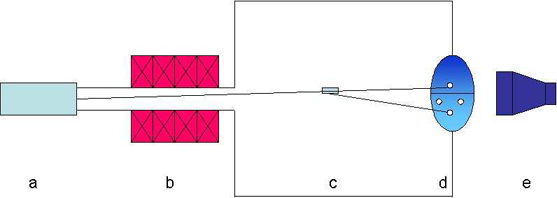Reflection High Energy Electron Diffraction
Reflection high energy electron
diffraction (RHEED) has been the “work horse” for real-time
quantitative characterization of epitaxial growth, owing to its surface
sensitivity, large working
distance, and the reflection geometry compatible with deposition. The
grazing incident angle for
the RHEED beam with respect to the surface, typically 1-2 degrees gives
rise to a very small
penetration depth, resulting in a diffraction pattern that is sensitive
to only the outer most surface
layer. Therefore, by monitoring the RHEED patterns during growth and
across the sample,
evolution of surface structures can be examined systematically.  Schematic diagram of RHEED: a)
RHEED gun, b) deflecting, rocking and scanning coils, c) sample, d)
phosphor screen, e) CCD camera Schematic diagram of RHEED: a)
RHEED gun, b) deflecting, rocking and scanning coils, c) sample, d)
phosphor screen, e) CCD camera Examples of RHEED patterns for
various surface morphologies, e.g. atomically smooth
2-dimensional (2D) surface and atomically rough 3D surface. Examples of RHEED patterns for
various surface morphologies, e.g. atomically smooth
2-dimensional (2D) surface and atomically rough 3D surface.
|